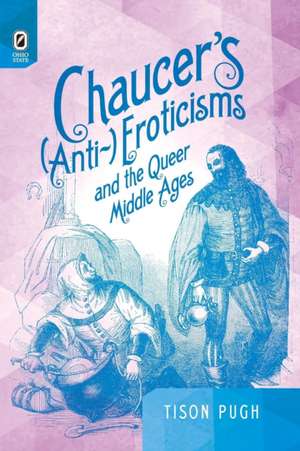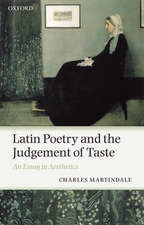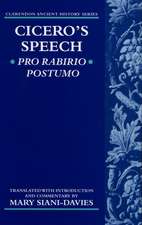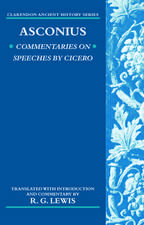Chaucer's (Anti-)Eroticisms and the Queer Middle Ages: Interventions: New Studies Medieval Cult
Autor Tison Pughen Limba Engleză Paperback – 31 mai 2016
Using queer theory to untangle all types of nonnormative sexual identities, Tison Pugh uses Chaucer’s work to expose the ongoing tension in the Middle Ages between an erotic culture that glorified love as an ennobling passion and an anti-erotic religious and philosophical tradition that denigrated love and (perhaps especially) its enactments. Chaucer’s (Anti-)Eroticisms and the Queer Middle Ages considers the many ways in which anti-eroticisms complicate the conventional image of Chaucer. With chapters addressing such topics as mutual masochism, homosocial brotherhood, necrotic erotics, queer families, and the eroticisms of Chaucer’s God, Chaucer’s (Anti-)Eroticisms will forever change the way readers see the Canterbury Tales and Chaucer’s other masterpieces.
For Chaucer, erotic pursuits establish the thrust and tenor of many of his narratives, as they also expose the frustrations inherent in pursuing desires frowned upon by the religious foundations of Western medieval culture. One cannot love freely within an ideological framework that polices sexuality and privileges the anti-erotic Christian ideals of virginity and chastity, yet loving queerly creates escapes from social structures inimical to amour and its expressions in the medieval period. Thus Chaucer is not just England’s foundational love poet, he is also England’s foundational queer poet.
For Chaucer, erotic pursuits establish the thrust and tenor of many of his narratives, as they also expose the frustrations inherent in pursuing desires frowned upon by the religious foundations of Western medieval culture. One cannot love freely within an ideological framework that polices sexuality and privileges the anti-erotic Christian ideals of virginity and chastity, yet loving queerly creates escapes from social structures inimical to amour and its expressions in the medieval period. Thus Chaucer is not just England’s foundational love poet, he is also England’s foundational queer poet.
Preț: 327.16 lei
Nou
Puncte Express: 491
Preț estimativ în valută:
62.62€ • 68.04$ • 52.64£
62.62€ • 68.04$ • 52.64£
Carte tipărită la comandă
Livrare economică 16-22 aprilie
Preluare comenzi: 021 569.72.76
Specificații
ISBN-13: 9780814253021
ISBN-10: 0814253024
Pagini: 254
Dimensiuni: 152 x 229 x 18 mm
Greutate: 0.38 kg
Ediția:1
Editura: Ohio State University Press
Colecția Ohio State University Press
Seria Interventions: New Studies Medieval Cult
ISBN-10: 0814253024
Pagini: 254
Dimensiuni: 152 x 229 x 18 mm
Greutate: 0.38 kg
Ediția:1
Editura: Ohio State University Press
Colecția Ohio State University Press
Seria Interventions: New Studies Medieval Cult
Recenzii
“Chaucer’s (Anti-)Eroticisms and the Queer Middle Ages is exhaustively researched both in the theoretical works that underpin its arguments and in the practical criticism of the various Chaucerian works under examination. With its careful and thoughtful readings, this book is a convincing expansion of the fields of both Chaucer studies and queer medieval studies.” —Robert Sturges, Arizona State University
“Tison Pugh’s interest in the anti-erotic, and in the contradictions of medieval discourses about chastity and married love, promises to solve some of the problems inherent in Chaucer criticism. Pugh’s Chaucer is queer because he’s aware of his culture’s contradictions and writing through them, and Pugh’s careful thinking and reading opens up many new avenues for study and research. Chaucer’s (Anti-)Eroticisms and the Queer Middle Ages is, without a doubt, an important contribution to the fields of Chaucer studies, medieval literary studies, and queer literary studies and to the study of the history of sexuality.” —Masha Raskolnikov, Cornell University, author of Body Against Soul: Gender and Sowlehele in Middle English Allegory
“Tison Pugh’s interest in the anti-erotic, and in the contradictions of medieval discourses about chastity and married love, promises to solve some of the problems inherent in Chaucer criticism. Pugh’s Chaucer is queer because he’s aware of his culture’s contradictions and writing through them, and Pugh’s careful thinking and reading opens up many new avenues for study and research. Chaucer’s (Anti-)Eroticisms and the Queer Middle Ages is, without a doubt, an important contribution to the fields of Chaucer studies, medieval literary studies, and queer literary studies and to the study of the history of sexuality.” —Masha Raskolnikov, Cornell University, author of Body Against Soul: Gender and Sowlehele in Middle English Allegory
“Tison Pugh’s interest in the anti-erotic, and in the contradictions of medieval discourses about chastity and married love, promises to solve some of the problems inherent in Chaucer criticism. Pugh’s Chaucer is queer because he’s aware of his culture’s contradictions and writing through them, and Pugh’s careful thinking and reading opens up many new avenues for study and research. Chaucer’s (Anti-)Eroticisms and the Queer Middle Ages is, without a doubt, an important contribution to the fields of Chaucer studies, medieval literary studies, and queer literary studies and to the study of the history of sexuality.” —Masha Raskolnikov, Cornell University, author of Body Against Soul: Gender and Sowlehele in Middle English Allegory
Notă biografică
Tison Pugh is professor of English at University of Central Florida.
Cuprins
Chapter 1––Introduction: Chaucer’s (Anti-)Eroticisms and the Queer Middle Ages
Chapter 2––Mutual Masochism and the Hermaphroditic Courtly Lady in Chaucer’s Franklin’s Tale
Chapter 3––“For to be sworne bretheren til they deye”: Satirizing Queer Brotherhood in the Chaucerian Corpus
Chapter 4––Necrotic Erotics in Chaucerian Romance: Loving Women, Loving Death, and Destroying Civilization in the Knight’s Tale and Troilus and Criseyde
Chapter 5––Queer Families in the Canterbury Tales: Fathers, Children, and Abusive Erotics
Chapter 6––Chaucer’s (Anti-)Erotic God
Chapter 7––Epilogue: Chaucer’s Avian Amorousness
Chapter 2––Mutual Masochism and the Hermaphroditic Courtly Lady in Chaucer’s Franklin’s Tale
Chapter 3––“For to be sworne bretheren til they deye”: Satirizing Queer Brotherhood in the Chaucerian Corpus
Chapter 4––Necrotic Erotics in Chaucerian Romance: Loving Women, Loving Death, and Destroying Civilization in the Knight’s Tale and Troilus and Criseyde
Chapter 5––Queer Families in the Canterbury Tales: Fathers, Children, and Abusive Erotics
Chapter 6––Chaucer’s (Anti-)Erotic God
Chapter 7––Epilogue: Chaucer’s Avian Amorousness
Descriere
Explores the ongoing tension in the Middle Ages between an erotic culture that glorified love as an ennobling passion, and an anti-erotic religious and philosophical tradition that denigrated love and its enactments.



































